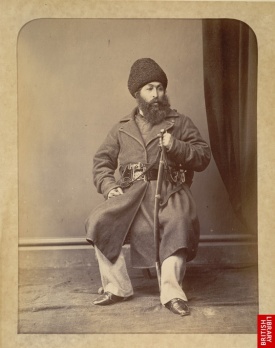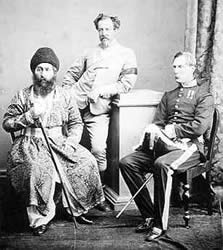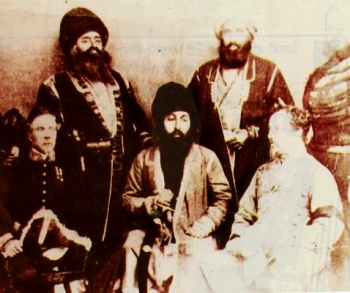Sher Ali Khan
Sher Ali Khan (1825–Feb. 21, 1879) was the Emir (Ruler) of Afghanistan from 1863 to 1866 and again from 1868 until his death in 1879. He was the third son of Dost Mohammed Khan, founder of the Barakzai Dynasty in Afghanistan. His older brother, Mohammad Afzal Khan seized the control of Afganistan from 1863-66. His eldest brother Akbar Khan Muhammad led the attack in which the Sikh General Hari Singh Nalwa was martyred.
The Great Game, the Russian Bear and the British Lion
In an earlier version of recent history Russia had designs on Afghanistan while Britain hoped to keep them out of the one country that would put their great adversary on the 'doorstep' to their richest colony, India. Sher Ali Khan tried to play each against the other and remain neutral in their conflict. In 1878, the neutrality failed and the Second Anglo-Afghan War erupted. As British forces marched on Kabul, Sher Ali Khan left Kabul seeking polical asylum in Russia. He, like his father, had hoped to return the former Afgani provinces of the Durranis to Afgan and Muslim control. But Britain had already awarded Jammu and Kashmir to Gulab Maharaj.
Rather than taking control as a victor he used the tried and true method of winning a toehold in India again by arranging a marriage between one of his daughters and a prominent Tribal Chief of the Gakhars, Khan Bahadur Raja Jahandad Khan. Today the lands the Gakhars held are now part of Pakistan.
Sher Ali Khan died in Mazar-e Sharif, Afganistan leaving the throne to his son Mohammad Yaqub Khan.
Mazar-e Sharif refers to the widely held belief that the Mazar (tomb) of Hazrat Ali ibn Abi Talib, the Prophet Muhammad's son-in-law and cousin lies in the city.
A Lighter, younger Sher Ali Khan or Maharaja Ranjit Singh?
The third photo is in very bad condition (scanned out of a newspaper— print in reverse can clearly be seen between the men's heads) Sher Ali Khan appears with the same British Soldiers, notice the high forehead and tied armband of one and the same plumed hat and two medals of the other. Sher Ali Khan wears the same tall karakul (black lamb's wool hat) in all three photos. The hats with a high peak to repel snow are the earlier version of the modern hats worn by Soviet Generals and a version popularized by Hamid Karzai the President of Afganistan.
The wool of the karakul (black lake in Uzbeck) sheep can resist extremely cold temperatures. The version worn by Mr. Karzai is the Qayche Na-khordah (not cut version) which is surrounded in controversy. It has even being declared Haram (forbidden) by Islamic religious scholars. It is made from the skin of unborn baby Karakul sheep.
The third photo has caused some controversy as some have claimed the photo to be one made of Maharaja Ranjit Singh, Hari Singh Nalwa and the British Viceroy Bentink in 1809. Neither officer has any resemblence to Viceroy Bentink while they are as stated, clearly recognizeable in both photos. They would have been about 5-10 yrs. of age at the time of the Maharaja's and the Viceroy's meeting.



